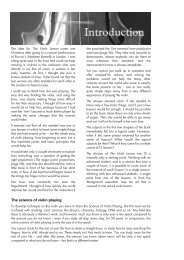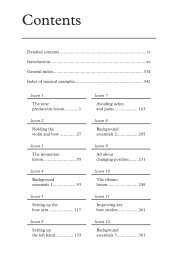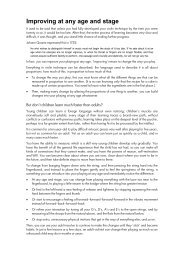here - Simon Fischer
here - Simon Fischer
here - Simon Fischer
You also want an ePaper? Increase the reach of your titles
YUMPU automatically turns print PDFs into web optimized ePapers that Google loves.
Scales and arpeggios 141<br />
Note about rhythm and accent practice 141<br />
Vibrato 142<br />
Playing scales as music 142<br />
Bowing patterns 143<br />
Metronome practice 144<br />
Improvising 148<br />
Chromatics: isolating the shift 149<br />
Short-cuts: thirds, sixths and<br />
fingered octaves 150<br />
Part 5 – Shifting<br />
The feel of the hand and fingers 153<br />
Memorizing the feel of the position 153<br />
Using glissando to measure the shift 156<br />
Comparing shifting to a different finger 156<br />
Comparing shifting to adjacent notes 157<br />
Semitone shifts with one finger 158<br />
Substitutions 159<br />
Intermediate notes 160<br />
Classical shifts 160<br />
Romantic shifts 163<br />
Combination shifts 165<br />
Exchange shifts 166<br />
Ascending shifts: practise three ways 169<br />
Position-finding using intermediate notes 170<br />
Timing the shift 172<br />
Speed of shift 172<br />
Slow arrival speed 172<br />
Taking time from the note<br />
before the shift 175<br />
Missing out the note before the shift 177<br />
Co-ordination: overlapping with<br />
the previous bow 179<br />
Playing in one position 181<br />
Lightening the shift 182<br />
Releasing the hand and fingers 182<br />
Ghosting 182<br />
‘Trilling’ shifts 183<br />
Isolating the shift 186<br />
Harmonics 188<br />
Shifting to a harmonic 188<br />
Sustaining natural harmonics<br />
without the finger 189<br />
Chromatic glissando 190<br />
Speed of glissando 190<br />
Building the run in groups 191<br />
Using an ordinary fingering as<br />
a model 192<br />
Part 6 – Intonation<br />
The feel of the hand and fingers 193<br />
Holding down fingers 193<br />
Square and extended finger shapes 194<br />
Filling in spaces between notes 195<br />
Practising without rhythm or real tone,<br />
learning notes only 196<br />
Tone–semitone patterns 196<br />
Playing the same notes in<br />
different positions 200<br />
Starting a phrase on different keynotes 201<br />
Playing the same fingerings on<br />
different strings 202<br />
Extensions: dividing the distance 203<br />
Extensions: notes before or after 206<br />
Uniform intonation 207<br />
Testing, relating, comparing 207<br />
Tuning scales: three stages 210<br />
Same notes, different octaves 212<br />
Sharps and flats 214<br />
Wide and narrow semitones 214<br />
Fast intonation 215<br />
Isolating individual notes 216<br />
Marking arrows 216<br />
Accents 216<br />
Playing intervals not notes 217<br />
Tuning to a piano, then adjusting<br />
sharps and flats 218<br />
Double stops 218<br />
Using the ‘third tone’ as a point<br />
of reference 218<br />
Using the third tone to tune<br />
single stops 220<br />
Thirds: naming intervals and<br />
spacing of fingers 221<br />
Thirds and fingered octaves:<br />
placing in blocks 222<br />
Thirds: using the perfect fourth 223<br />
Tuning perfect fifths 224<br />
Playing one string at a time while<br />
fingering both strings 225<br />
Leaving fingers down to have time<br />
to listen 227<br />
Tenths: moving from one to another 228






